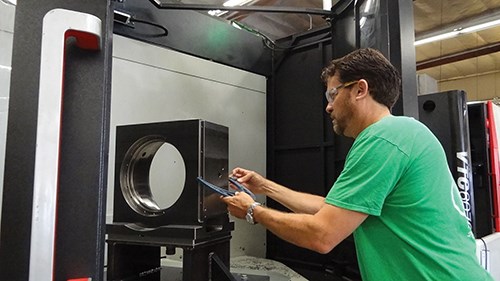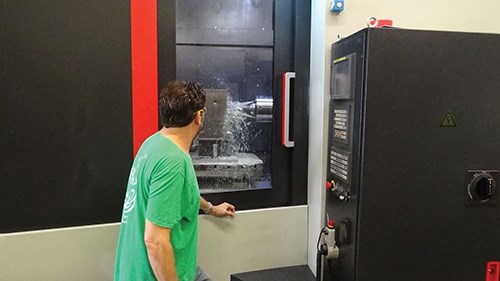HMC Saves Floor Space, Increases Production Capacity
When Calmotion LLC's production capacity fell behind demand for its rotary products, it added horizontal machining with the SMTCL HMC80 for reduced operations and setup times.
Share




Hwacheon Machinery America, Inc.
Featured Content
View More
Takumi USA
Featured Content
View More



Manufacturing challenges don’t always end once a company successfully makes a product. In fact, success often leads to increased production, which, in turn, presents unexpected additional challenges. Calmotion LLC (Chatsworth, California) had to change its machining process when demand for its rotary products increased. By adding horizontal machining from SMTCL Americas (City of Industry, California), however, the company was able to avoid adding many more machines and additional floor space.
Calmotion specializes in manufacturing control and mechanical products for CNC applications. With more than 60 years in the machine tool industry, owner Larry de Caussin says that the machines cutting his products are the most important factor in producing quality parts.
Mr. de Caussin, who with his family introduced Fadal vertical machining centers, has developed a line of rotary products designed for cost-effective four- and five-axis machining. Machining of Calmotion’s rotary tables has to be extremely accurate, as any product deviation is magnified the farther a customer machines from the center of rotation. Also, the rigid, heavy castings require a powerful machine to remove chips.
To meet these requirements, Mr. de Caussin originally relied on the high-torque spindles and boxway construction of the Fadal vertical machining centers. However, high customer demand for the rotary product and the introduction of new product designs became a challenge for Calmotion. The only way to increase production without adding machines and floor space was to change the manufacturing process.
Rodney de Caussin, senior vice president, met with Jerry McCarty of SMTCL to discuss ways to increase production. The men agreed that horizontal machining was a natural step. By using a two-pallet machine, Calmotion could reduce the number of operations and setup time, Mr. de Caussin says. As an added benefit, he could see the horizontal running at SMTCL’s Southern California Technical Center before he purchased it.
Once Mr. de Caussin put the SMTCL HMC80 into production, he realized that it was doing the work of six VMCs in terms of efficiency. The HMC’s 653 foot-pounds of torque combined with 1,570-ipm rapids also reduced cycle times, and the 800-mm pallets provided a large work area for the company’s custom fixtures. Calmotion was able to increase speeds and feeds while realizing all the setup benefits of a horizontal. For instance, after the program finished on the VMC, the operator would blow off chips, unload the finished part, and set up a new part in the fixture. This process took about 5 min. while the machine sat idle. With the dual-pallet system on the HMC, the entire process takes place on the idle pallet while the spindle is machining a part on the active pallet, enabling the company to produce 20 percent more parts per shift than it could on the VMC.
And, although it removes metal much faster, the 70,000-pound machine remains extremely rigid.
“This shows up in the part finish, which is just beautiful,” Mr. de Caussin says.
The transition from vertical to horizontal machining meant that Calmotion had to reprogram the part. However, the ability to run the part in just one setup ended up saving time by combining what was previously four programs. Also, the SMTCL HMC80’s 50-taper spindle enables a heavier cut, and its faster rapids resulted in a time savings of 20 percent. One-step machining prevents work in progress, which helps with shop cleanliness and less scrap, the company says.
In addition, the high-pressure through-tool coolant is designed to move chips off the part more efficiently and keep it cleaner. Previously, the company redirected coolant by hand, but that is no longer the case. Without operator intervention, the shop is able to realize even more time savings, Mr. de Caussin says.
Another way the HMC helped ramp up production was through increased tool life. Although Calmotion uses the same size cutting tools as it previously did on the VMC, the 50-taper HMC’s rigidity and weight produces less vibration, which, in turn, increases tool life.
“There have been no complications or handicaps with the tooling, and it has been a smooth transition,” Mr. de Caussin says.
The SMTCL HMC80 is wired for a Renishaw NC4 laser tool-setting drill. The larger toolchanger enables duplicate tools, which enables Calmotion to immediately replace worn tools automatically, lowering setup and maintenance time.
When asked about the overall thoughts on their new HMC, Mr. de Caussin says, “It has all of the benefits we had hoped for. Although the chip management was not expected, it was a great plus. After 60 years of being in the machine tool industry, even I am impressed.”
Related Content
Quick-Change Tool Heads Reduce Setup on Swiss-Type Turning Centers
This new quick-change tooling system enables shops to get more production from their Swiss turning centers through reduced tool setup time and matches the performance of a solid tool.
Read MoreCNC Machine Shop Honored for Automation, Machine Monitoring
From cobots to machine monitoring, this Top Shop honoree shows that machining technology is about more than the machine tool.
Read More5 Tips for Running a Profitable Aerospace Shop
Aerospace machining is a demanding and competitive sector of manufacturing, but this shop demonstrates five ways to find aerospace success.
Read More6 Machine Shop Essentials to Stay Competitive
If you want to streamline production and be competitive in the industry, you will need far more than a standard three-axis CNC mill or two-axis CNC lathe and a few measuring tools.
Read MoreRead Next
5 Rules of Thumb for Buying CNC Machine Tools
Use these tips to carefully plan your machine tool purchases and to avoid regretting your decision later.
Read MoreRegistration Now Open for the Precision Machining Technology Show (PMTS) 2025
The precision machining industry’s premier event returns to Cleveland, OH, April 1-3.
Read MoreBuilding Out a Foundation for Student Machinists
Autodesk and Haas have teamed up to produce an introductory course for students that covers the basics of CAD, CAM and CNC while providing them with a portfolio part.
Read More










































.jpg;maxWidth=300;quality=90)









